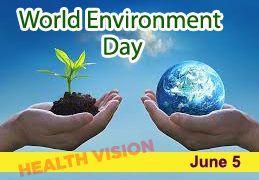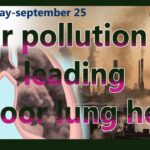Environmental pollution is also a factor for infertility. There are fears that industrial and agricultural chemicals and heavy metal pollutants are disrupting the reproductive biology animals and may also be affecting human fertility and fetal development.


Environment motivates to react: We are miserable when are in desert and delighted when we are in lush garden. In a hospital we are in different mood and in disco different. Environment motivates us to change our mood and reaction is in accordance.
Pollution:
Pollution is the release of environmental contaminants. The act or process of polluting or the state of being polluted, especially the contamination of soil, water, or the atmosphere by the discharge of harmful substances.
1. Soil pollution


Soil pollution is defined as the build-up in soils of persistent toxic compounds, chemicals, salts, radioactive materials, or disease causing agents, which have adverse effects on plant growth and animal health.
2. Water pollution:
Water pollution occurs when undesirable foreign substances are introduced into natural water. The substances may be chemical or biological in nature. Common pollutants include human or animal waste; disease-producing organisms; radioactive materials; toxic metals such as lead or mercury; agricultural chemicals such as pesticides, herbicides, or fertilizers; acid rain, Industrial discharge of chemical wastes and byproducts, Discharge of poorly-treated or untreated sewage, petroleum products, and high-temperature water discharged from power plants, often called “thermal pollution.” Pollutants in water are dangerous for human or animal consumption and harm crops.


Air pollution is the presence of any chemical, physical (e.g. particulate matter), or biological agent that modifies the natural characteristics of the atmosphere. The atmosphere is a complex, dynamic natural gaseous system that is essential to support life on planet earth.
Air pollution is composed of many environmental factors. They include carbon monoxide, nitrates, sulfur dioxide, ozone, lead, secondhand tobacco smoke and particulate matter. Factory emissions, vehicle emissions cause air pollution.
4. Noise Pollution
Any unwanted man-made sound that penetrates the environment is noise pollution. In general noise pollution refers to any noise irritating to one’s ear which comes from an external source.
Noise pollution can be caused by many sources including highways, vehicles, factories, concerts, air-conditioners, engines, machine, aircraft, helicopters, alarms, public address systems, industrial development and construction work.
Effect of Pollution on Health:
1. Pollutants can cause disease, including cancer, lupus, immune diseases, allergies, and asthma.
2. Adverse air quality can kill many organisms including humans. Worldwide air pollution is responsible for large numbers of deaths and cases of respiratory disease.
3. Ozone pollution can cause respiratory disease, cardiovascular disease, throat inflammation, chest pain and congestion.
4. Water-borne diseases are infectious diseases spread primarily through contaminated water. Water pollution causes approximately 14,000 deaths per day, mostly due to contamination of drinking water by untreated sewage in developing countries. Cholera, Hepatitis, Dysentery and Typhoid are the more common water-borne diseases.
5. Oil spills can cause skin irritations and rashes.
6. Noise pollution can cause hearing loss, high blood pressure, stress, sleep disturbance, and High noise levels can contribute to cardiovascular effects.
Pollution and Fertility:
Environmental factors contribute to the severity of infertility, and that this may worsen the effects of pre-existing genetic or medical risk factors. Stress and environmental pollution are two of the main causes of growing infertility among urban couples.
Worldwide, one in every six couples has difficulty in conceiving. About 50 percent of the infertility problems are contributed by the male factor. But stress and environmental pollution are considered two key factors for childlessness among couples now.
An increasing number of reports suggest that chemical and physical agents in the environment, introduced and spread by human activity may affect fertility in humans. Stress and environmental pollution reduce the sperm count in males. While a couple is considered infertile if after one year of adequate unprotected intercourse the woman fails to conceive, the problem in our society becomes more social.
There are fears that industrial and agricultural chemicals and heavy metal pollutants are disrupting the reproductive biology animals and may also be affecting human fertility and fetal development.
Steps to taken to control Environment Pollution:
1. Encourage Afforestation: Afforestation is the process of converting open land into a forest by planting trees or their seeds.
2. Stop Deforestation: Deforestation results from removal of trees without sufficient reforestation; however, even with reforestation, significant biodiversity loss may occur.
3. Practice proper Waste management: is the collection, transport, processing (waste treatment), recycling or disposal of waste materials, usually ones produced by human activity, in an effort to reduce their effect on human health.
4. Proper management (Proper disposable) of Industrial wastes, chemicals, sewage, Pesticides & Fungicides, Poisonous chemicals should be done before disposed them into environment reservoirs.
5. Hospital wastes, syringes, needles etc should be properly treated before disposed. Syringes and needles tips should be cut down before disposed them into garbage so that one cannot reuse those materials.
6. Emission test to each vehicles should be done frequently.
Environmental Education:
Environmental education is a learning process that increases people’s knowledge and awareness about the environment and associated challenges, develops the necessary skills and expertise to address the challenges, and fosters attitudes, motivations, and commitments to make informed decisions and take responsible action
Since the industrial revolution many countries have experienced centuries of deforestation, and governments and Non-governmental organisations (NGO’s) should take up the programs of reafforestation (the restocking of existing forests and woodlands which have been depleted, with native tree stock) and also in supporting private and semi-private enterprise in programs of afforestation.
It is the duty of every one of us to preserve our environment in the best interest of our own health. It is also our duty to hand over a better environment to a next generation.


Dr. C. SHARATH KUMAR
Director and Chief Fertility Surgeon
Mediwave I.V.F & Fertility Research Hospital, City X-Ray Complex, Sayyaji Rao Road
Mysore-570 001 Phone: 0821-2444441, 4255019










